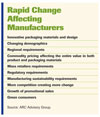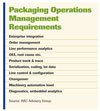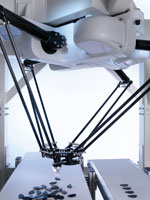
ELAU Robotic solutions allow machine builders to make robotic functionality an integral part of machine design.
Source ARC Advisory Group.
Source ARC Advisory Group.

Now, leading CPG manufacturers are implementing strategies that rely upon innovations in channels, services and consumer needs to regain high margins in their portfolios. Their product packaging has become increasingly varied - and is an integral part of product and service offerings.
Limited, higher-cost raw material, water and energy resources, as well as the impact current product packaging is having on the environment, have made sustainable manufacturing an equally important success factor. Two important trends impacting manufacturers are retailers’ sustainable packaging initiatives and the expanding base of socially and environmentally conscious consumers.

However, long-standing corporate policies in the CPG industry are in conflict with these rapidly emerging corporate and manufacturing strategies. Disconnects exist between operating budgets and capital expenditure budgets, in part because packaging machinery continues to be acquired based on capital expenditure budgets and amortized using standard accounting principles. To overcome these issues, an improved total cost of ownership (TCO) metric must be factored into opportunity costs and recurring operational expenditures. With this augmented TCO, rapid retirement of existing packaging machinery and the purchase of new machinery with the latest automation technology can be justified. This is an important consideration, since innovative machine designs can improve business performance by increasing the overall operating range of packaging operations.

Executing manufacturing strategies
Packaging operations are one of the most important facets in effecting new product innovations, increasing speed-to-market and achieving sustainability goals. Properly selected and deployed packaging automation and innovative machine designs enable marketing, supply chain, sustainability and lean manufacturing strategies, and ensure customer satisfaction.Individual packaging machines must handle more complex packages and provide increased flexibility to improve supply chain execution. But achieving operational excellence is not simply a case of adding overcapacity to the packaging line operations to improve supply chain performance. Existing assets must also be optimized by identifying and eliminating inefficiencies or limitations in current operations. This requires a packaging operations management system (POMS) that provides visibility into line operations and serves as a conduit between packaging operations and the business system. In addition, POMS should provide real-time information management, rapid line reconfiguration and expert knowledge for line operators.
The benefits of such a system extend beyond packaging operations and include maintenance, order processing, warehousing, shipping and logistics. POMS can help shorten planning cycles and reduce back office labor. It can also ensure manufacturers meet major retailers’ supply chain visibility initiatives that mandate improving delivery speed, reducing costs, improving case pack accuracy and providing more accurate and timely billing. POMS also plays a role in reducing the “cost of quality” and meeting the need for greater product safety due diligence. However, in and of itself, POMS is not all that is required for operational excellence; machine automation technology that supports an integrated network for the collection, storage, analysis and bi-directional exchange of information is also required.

Adept’s Quattro system features a four-arm Delta robot. Source: Adept Technology, Inc.
Automation systems
Over the last 10 years, innovative packaging machine designs incorporating mechatronic solutions have inspired a culture of rapid innovation by packaging machinery builders that are breaking barriers in design by combining functions once considered the domain of standalone systems. Now, integral robotics and purpose-built solutions can accommodate package designs and product mix in ways unachievable a generation ago.Automation technology and building blocks are in place for the next level of alignment of operations with business initiatives. Machinery designs allow for incremental increases in functionality, and builders are developing cost-effective ways to upgrade machines in the field when requirements change or there is a need for production flexibility. Some manufacturers consider this type of automation to be a luxury. However, progressive manufacturers consider TCO a requirement.
In addition, packaging machinery automation systems that support the accurate collection and storage of real-time performance information, along with precise closed-loop machine control in critical aspects of the machine, are essential for operations management. For example, bottle-capping machinery using servo mechanisms delivers more precise torque control than machinery with traditional closed loop control techniques. Precise control combined with accurate data collection ensures continuous quality verification on every bottle.
Packaging automation systems selection
The process of identifying and procuring quality packaging machinery is undergoing a radical change. In many instances, the traditional segmentation of packaging is falling by the wayside as increasing numbers of machine builders consider the entire packaging process and extend beyond the limits of traditional domains. Today’s builders are working with a generation of automation technology that enables rapid innovation and integration of functionality once considered the purview of their competitors. By adding broader technical competency to their organizations, they are leveraging a combination of technologies once out of reach. In many instances, packaging machinery now exceeds the expectations of CPG manufacturers.Despite these advances, the best machine builders may be overlooked by CPG manufacturers that do not have the resources to perform research outside of traditional suppliers.
Design innovations
Machine builders are making tremendous inroads in automation integration, reusable software and innovative machine designs that leverage robotics, machine vision, embedded sensors and electronic motion control, and they are developing new-generation machines that handle a diverse range of product and packaging options while satisfying regulatory and corporate demands for electronic genealogy. For instance, electronic motion adds speed, precise control, quiet operation, reliability and configurability to machinery while robotics deliver flexibility and machine vision satisfies verification requirements. Advanced packaging lines are employing a combination of technologies as the cost of automation is no longer prohibitive.Mechatronics in machine design
Mechatronic solutions have effectively eliminated once prevalent PLC-centric solutions and replaced them with automation that focuses on integration of motion control, auxiliary logic control and data management. The new generation of mechatronic machine designs is energy efficient and highly reliable. Designed around servo technology, these mechatronic machines allow smaller designs, built-in modularity and greater flexibility.Typically, their drive shaft and cams are replaced by a “virtual master,” a simulated master axis from which all other motion is derived through electronic gearing or cam tables. Digitally controlled content has increased with the integration of servos to replace a myriad of mechanical solutions such as magnetic clutches on bottle cappers or line shafts and gear boxes on flow wrappers and cartoners.
Since machine builders are placing a greater emphasis on rapid changeover, diagnostic tools and a continuous flow of goods, servo-based solutions have been developed to enable machinery operation at much higher rates than ever before.
This, in turn, has led to the introduction of integral robotics, allowing machine builders to refine designs to keep packages moving throughout the process without the use of conveyance systems. By eliminating intermediate conveyance stages, the overall footprint of the machinery is reduced.
Modularity
Modularity involves taking a black box approach to designing and programming machines. A black box is a finished, tested module built separately and assembled in the field to customers’ requirements. However, the ultimate black box is a mechatronic subassembly consisting of ready-to-run mechanical and intelligent electrical components where mechatronic units can be combined as machine components such as conveyors, cutters, sorters or sealers. Modular machines are reconfigured later to accommodate different product configurations or to meet changing demand by modifying the flow of products in a production system. Machine modularity allows machine builders to configure a packaging machine based on functional subsystems such as bottle carousels, labelers and wrappers. The integration of a robotic manipulator further leverages the concept of modularity by encapsulating this element of the machine as a functional subcomponent.Sensor-based machinery
Quality is an imperative in every industry. Yet, the operational speed of machinery often exceeds the ability of human operators to monitor production quality. Consequently, machinery producers are integrating sensor technology inline to identify unfilled cartons or bottles. For instance, bottling machines rely on coriolos flow meters to dynamically measure density and the fluid contents in a bottle. The recipe for the production is loaded into the control system, and the readings from the coriolis flow meter dynamically check that the profile of the liquid matches the recipe. Discrete bottle fillers are also adding vision detectors to assure the correct count is inserted into each bottle. All of these features are enabling machinery to run at higher speeds, virtually eliminating production defects.Bottle capping is reaping the benefits of electronic setting of torque profiles with servos from Pneumatic Scale/Angelus and its Italian subsidiary Arol, as well as servo capping from New England Machinery. With these servos and servo capping, operators changing a line over to a new type of bottle or cap simply designate the torque profile as a parameter rather than mechanically setting clutches. Torque control is an order of magnitude better, and the torque feedback values from purpose-built servos provide an instant verification and record of capping quality.
Automated changeover
While electronic servos have primarily been used in continuous motion machinery, the technology is now also used to set variable gauge stops. The advantages of automated changeover are derived from the ability to provide network connectivity to the individual machines, thereby eliminating the need for manual intervention. This improves changeover time and eliminates the potential for human error.Robotic packaging lines
Packaging line designs that utilize the improved capabilities of robotics are reinventing the status quo, and packaging machine builders and robotics suppliers are playing a major role in the build-up of highly flexible packaging lines. While robotic lines operate at a slower pace, their overall production output is often greater because robotic packaging lines are digitally reconfigurable and never need to stop for changeovers. Going forward, the industry challenge will be to determine the optimal combination of rapid changeover and slower robotic lines that create a balance with dedicated high-speed lines.While traditional six-axis and Cartesian robots have dominated end-of-line packaging operations, the Delta-style robot is the incipient robotic configuration being utilized for picking individual products, primarily due to its exceptional speed. Adept’s Quattro parallel robot has taken the Delta concept one step further by using a four-arm rotational platform that achieves rotation without an extra telescoping joint. Both Adept’s and Elau’s robotic solutions are self-contained systems that incorporate embedded amplifiers and compact controls, consistent with the concept of modular machine design.
The concept of integrating product design with the entire manufacturing process is now achievable with the implementation of highly flexible robotic packaging lines. In the future, digital designs of packages will drive digital reconfiguration of robotic packaging lines; robotics will add flexibility to add leaflets, gadgets or other types of promotional materials to late-stage packaging processes; and top-loading of cartons and wallet packs will be achievable, enabling end-users to tackle pressing customization demands.



